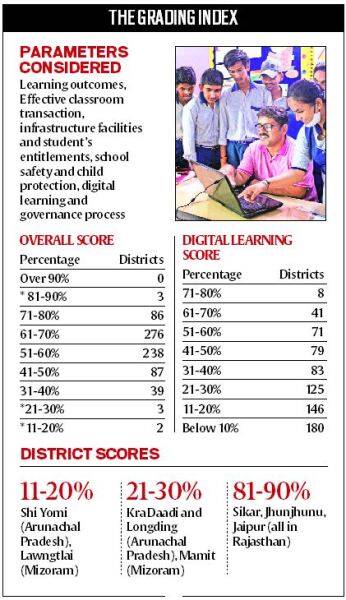Governance
Performance Grading Index for Districts (PGI-D)
- 28 Jun 2022
- 7 min read
For Prelims: Performance Grading Index for Districts (PGI-D), Unified District Information System for Education Plus (UDISE +), National Achievement Survey (NAS).
For Mains: PGI-D, Related Initiatives, Performance of School Education System in Districts.
Why in News?
Recently, the Department of School Education and Literacy (DoSE&L), Ministry of Education (MoE) released the Centre’s first-ever Performance Grading Index for Districts (PGI-D) for 2018-19 and 2019-20.
- In June, 2021, the Union Education Minister has approved the release of Performance Grading Index (PGI) 2019-20 for States and Union Territories.
What is the Index All About?
- About:
- PGI-D assesses the performance of the school education system at the district level by creating an index for comprehensive analysis.
- The PGI-D assessed district-level performance in school education based on the data collected from various sources, including Unified District Information System for Education Plus (UDISE +), National Achievement Survey (NAS), 2017 and data provided by respective districts.
- Methodology:
- Structure: The PGI-D structure comprises a total weightage of 600 points across 83 indicators, which are grouped under six categories:
- Outcomes, Effective Classroom Transaction, Infrastructure Facilities & Student’s Entitlements, School Safety & Child Protection, Digital Learning and Governance Process.
- Two categories — digital learning and effective classroom transaction have been added in the backdrop of the Covid-19 pandemic. However, these categories were not part of the state-level PGI.
- These categories are further divided into 12 domains.
- Outcomes, Effective Classroom Transaction, Infrastructure Facilities & Student’s Entitlements, School Safety & Child Protection, Digital Learning and Governance Process.
- Structure: The PGI-D structure comprises a total weightage of 600 points across 83 indicators, which are grouped under six categories:
- Assessment Grades: The PGI-D grades the districts into 10 grades. The highest achievable grade is ‘Daksh’, which is for districts scoring more than 90% of the total points in that category or overall.
- It is followed by ‘Utkarsh’ (81% to 90%), ‘Ati Uttam’ (71% to 80%), ‘Uttam’ (61% to 70%), ‘Prachesta-1’ (51% to 60%) and ‘Prachesta-2’ (41% to 50%).
- The lowest grade in PGI-D is ‘Akanshi-3’ which is for scores upto 10% of the total points.
- None of the districts figured in the highest ‘Daksh’ grade in both these years.
- Significance:
- The indicator-wise PGI score shows the areas where a district needs to improve. The PGI-D will reflect the relative performance of all the districts in a uniform scale which encourages them to perform better.
- At the same time, it will also act as a good source of information for best practices followed by States and UTs which can be shared.
- It helps all the stakeholders in the school education system, including the students, parents, teachers, and administrators to know the performance of their district vis-à-vis other districts.
What are the Key Highlights of the Report?
- Best Performers:
- Three districts from Rajasthan performed the best in the assessment.
- According to the report, the three districts — Sikar, Jhunjhunu, and Jaipur figured in ‘Utkarsh’ grade in 2019-20 in contrast to a year before when no district featured in that category.
- Rajasthan has the highest 24 districts in this grade, followed by Punjab (14), Gujarat (13), and Kerala (13).
- Three districts from Rajasthan performed the best in the assessment.
- Lowest Performers:
- The districts with the lowest scores (1 out of 50) in this category were:
- South Salmara-Mankachar (Assam), Alirajpur (Madhya Pradesh), North Garo Hills and South Garo Hills in Meghalaya, and Khowai (Tripura) in 2019-20.
- The 12 states/ UTs which don’t have a single district in the Ati-Uttam and Uttam are:
- Bihar, Goa, Jammu and Kashmir, Arunachal Pradesh, Manipur, Meghalaya, Mizoram, Nagaland, Sikkim, Tripura and Uttarakhand.
- The districts with the lowest scores (1 out of 50) in this category were:
- Progress:
- As per the report, the number of districts in all categories has increased.
- In the ‘Ati Uttam’ grade, the number of districts increased from 49 to 86 during 2018-19 to 2019-20 showing “remarkable improvements”.
- 33 districts improved their score in outcomes, but there is no grade-level improvement.
- The outcomes category includes learning outcomes of students, teachers’ availability and professional outcomes.
- Digital Learning Category: As compared to 2018-19, 20 districts have shown over 20% improvement while 43 districts bettered their score by over 10% during 2019-20.
- Infrastructural Facilities: 478 districts improved their score in 2019-20 as compared to 2018-19.
- Out of these 478, 37 districts made an improvement of over 20% improvement in score and 115 districts made an improvement of over 10% implying grade-level improvement.
- As per the report, the number of districts in all categories has increased.
What are the Other Government Initiatives in this Direction?
- National Education Policy, 2020: It aims at making “India a global knowledge superpower” by introducing several changes from the school to college level in the Indian education system.
- Samagra Shiksha: It is an integrated scheme for school education extending from pre-school to class XII to ensure inclusive and equitable quality education at all levels of school education.
- Mid Day Meal Scheme: It provides that every child within the age group of six to fourteen years studying in classes I to VIII who enrolls and attends the school, shall be provided hot cooked nutritional meals, free of charge every day except on school holidays.
- Eklavya Model School and Rajiv Gandhi National Fellowship Scheme (RGNF): These aim to encourage the students belonging to Scheduled Tribes (ST) community to pursue higher education.







